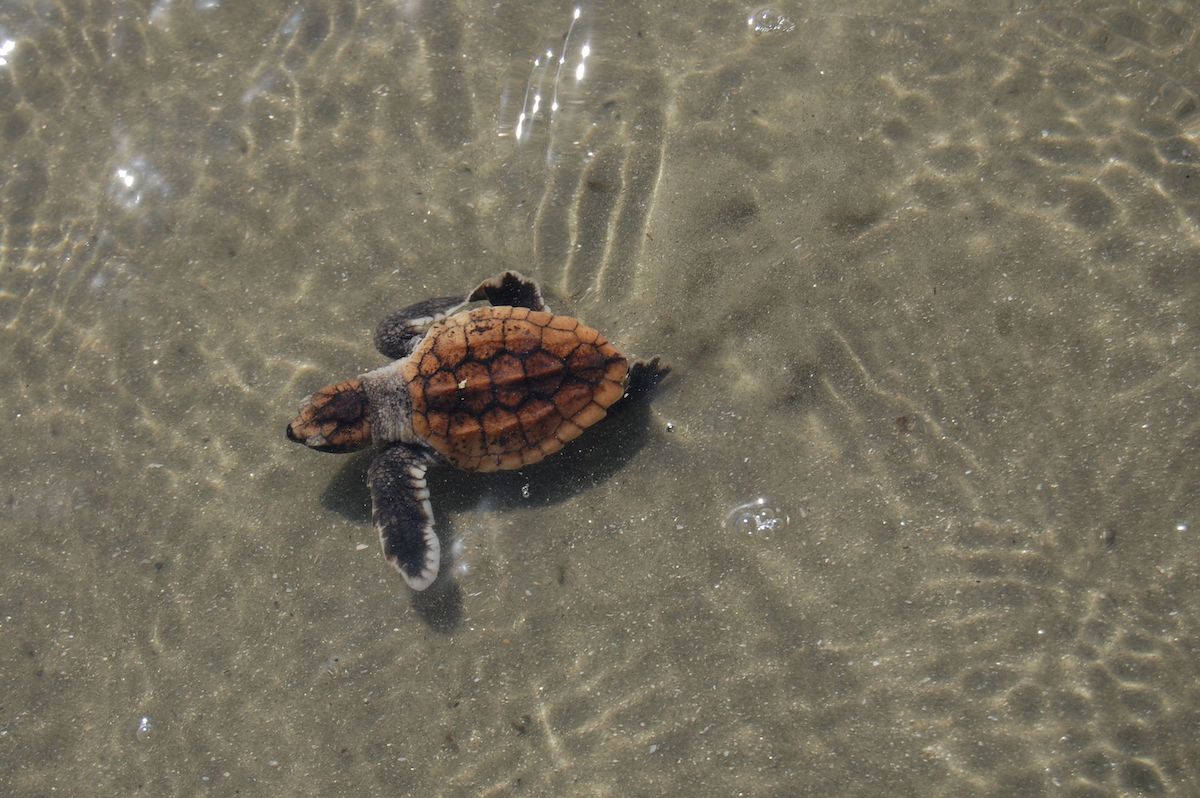
As a Certified Sustainable Community, Seabrook Island, South Carolina, is a wondrous refuge for nature lovers and local Charleston wildlife alike. Majestic herons stride through our lagoons, dolphins gracefully strand feed along the coast, and loggerhead sea turtles blissfully swim through our waters.
As our local community looks forward to a prosperous nesting season ahead of us, we are bringing you more information about these fascinating creatures who call Seabrook home and how you can help protect them for future generations.
Meet the Gentle Giants that Grace the Lowcountry’s Waters
The name “loggerhead” comes from the species’ massive heads and powerful jaws, allowing them to feed on the toughest prey, like shellfish, crabs, mussels, and other crustaceans. Despite their strength, they are often called gentle giants for their gentle nature, mellow disposition, and long lifespan. Loggerheads are also the largest hard-shell turtles, with mature adults growing up to four feet long and weighing up to 400 lbs. Their huge shells are known to house colonies of smaller sea plants and animals. Though they are a larger turtle species, these stunning creatures glide effortlessly through the water.
While they can survive for short periods on land, the ocean is the loggerhead’s natural environment. They can hold their breath for up to 4 hours and swim hundreds of thousands of miles to migrate from their nesting areas to fertile hunting grounds. Younger turtles spend the first 15 to 20 years in the deep, open water, while full-grown sea turtles stay closer to the shore to nest and hunt. Males stay in the water, while females climb back onto land only to lay their eggs. So, if you spot a Loggerhead on our Seabrook Island beaches, give them plenty of space to avoid spooking them back into the water.
How You Can Help Protect the Loggerhead Population
Since the development of our barrier island began, we have worked to protect and preserve the beautiful South Carolina beaches, natural ecosystems, and wildlife that define Seabrook. We have a robust turtle patrol organization on Seabrook Island as part of these ongoing efforts.
Every year, sea turtles lay almost 9,000 nests per year on the South Carolina beaches coast. Seabrook Island Turtle Patrol volunteers regularly scout the beaches to identify and protect local loggerhead nests, coordinating with the South Carolina Department of Natural Resources (SCDNR) to monitor reproductive and feeding behaviors.
Currently, loggerhead sea turtles are listed as threatened, which means they are likely to become endangered and are in danger of extinction within the foreseeable future under the U.S. Federal Endangered Species Act. As residents and visitors of Seabrook Island, here are three easy things you can do to help ensure this wonderful species is around for generations to come!
1 – Turn the lights out after 9 pm
Artificial lighting can discourage female sea turtles from laying their eggs, and after multiple attempts, they may be forced to lay their eggs in the ocean, which leaves them especially vulnerable. Similarly, hatchlings disoriented by the light may wander inland and become dehydrated. To help protect the nesting turtles and hatchlings that will reside on our beaches throughout the year, we want to remind residents and guests of Seabrook Island to keep seaward-facing lighting turned off from May 15th through October 31st between the hours of 9 pm and 8 am. If you need to use a light on the beach, cover it with a red lens. Both of these options significantly decrease the survival outlook for the hatchlings.
2 – Do not disturb loggerhead turtle nests
People and pets are not permitted to walk on the sand dunes or remove any vegetation because this is where many wildlife species make their nests, including loggerheads. The Turtle Patrol regularly monitors the beach, and the nests will be marked with an orange DNR sign and white pole. Please do not disturb them. If you see a nesting turtling or emerging hatchling, keep your distance, keep pets away, and notify the Turtle Patrol at 843-310-4280.
3 – Clear the beaches for the loggerheads
Nesting mothers and tiny hatchlings must make their way from their nests to the waters. Fill in any holes, level sand, flatten sandcastles, and other blockages to prevent the turtles from getting stuck along their journey. Remove all equipment, trash, food, and pet waste from the beach before leaving to avoid entangling the turtles and attracting predators. If you have a bonfire permit, extinguish the fire thoroughly by the required time and cover it with sand.
Image Credit: Peyton Bebout
Our tranquil barrier island has become a favorite destination for these gentle giants of the sea. We’d love for you to visit this summer and see the magic of the loggerhead hatch for yourself! If you want to get involved, the Turtle Patrol always seeks enthusiastic volunteers.
Thank you to our residents and guests for helping to reduce light pollution for the turtles who make our island their home. We’re looking forward to seeing plenty of loggerhead hatchlings this year!